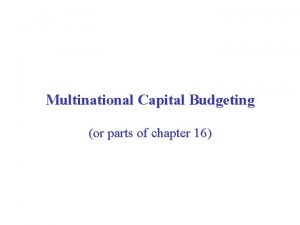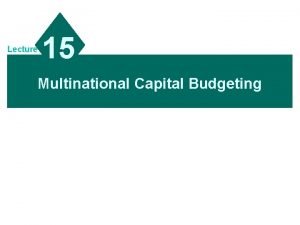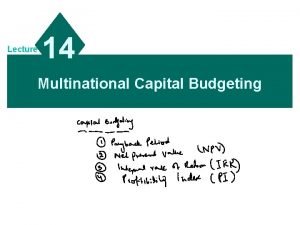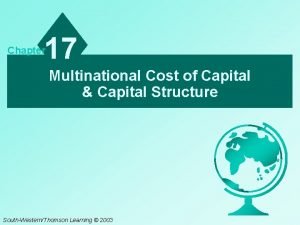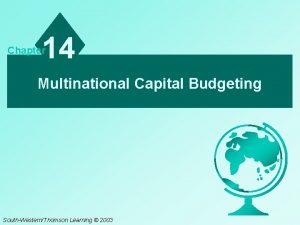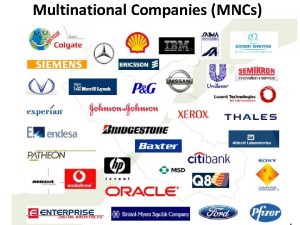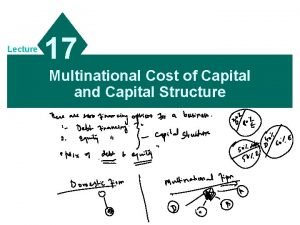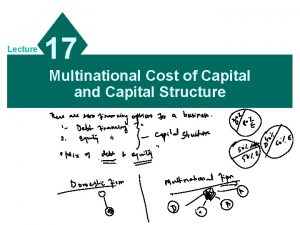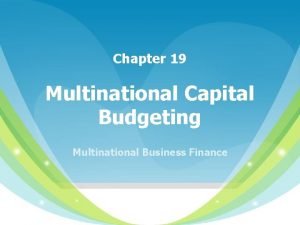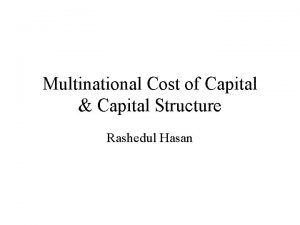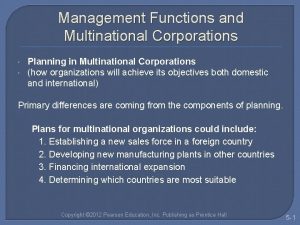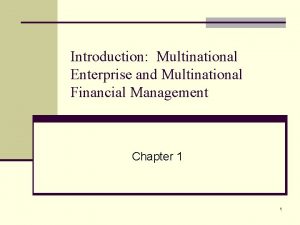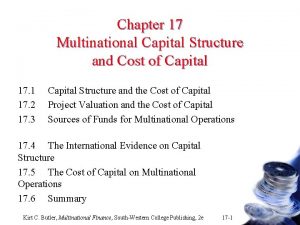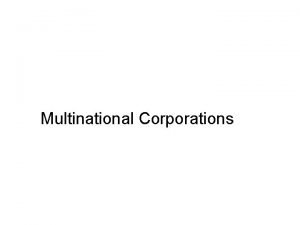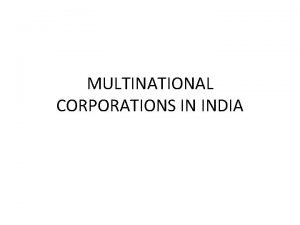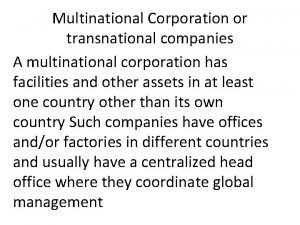Lecture 18 Multinational Cost of Capital and Capital



















- Slides: 19

Lecture 18 Multinational Cost of Capital and Capital Structure

17 - 2

Country Differences in the Cost of Equity • A firm’s return on equity can be measured by the risk-free interest rate plus a premium that reflects the risk of the firm. • The cost of equity represents an opportunity cost, and is thus also based on the available investment opportunities. • It can be estimated by applying a priceearnings multiple to a stream of earnings. • High PE multiple low cost of equity 17 - 3

Lexon’s Estimated Weighted Average Cost of Capital (WACC) for Financing a Project • To derive the overall cost of capital, the costs of debt and equity are combined, using the relative proportions of debt and equity as weights. 17 - 4

Using the Cost of Capital for Assessing Foreign Projects • When the risk level of a foreign project is different from that of the MNC, the MNC’s weighted average cost of capital (WACC) may not be the appropriate required rate of return for the project. • There are various ways to account for this risk differential in the capital budgeting process. 17 - 5

Using the Cost of Capital for Assessing Foreign Projects Derive NPVs based on the WACC. ¤ Compute the probability distribution of NPVs to determine the probability that the foreign project will generate a return that is at least equal to the firm’s WACC. Adjust the WACC for the risk differential. ¤ If the project is riskier, add a risk premium to the WACC to derive the required rate of return on the project. 17 - 6

Using the Cost of Capital for Assessing Foreign Projects Derive the NPV of the equity investment. ¤ Explicitly account for the MNC’s debt payments (especially those in the foreign country), so as to fully account for the effects of expected exchange rate movements. 17 - 7

Lexon’s Project: Two Financing Alternatives 17 - 8

The MNC’s Capital Structure Decision • The overall capital structure of an MNC is essentially a combination of the capital structures of the parent body and its subsidiaries. • The capital structure decision involves the choice of debt versus equity financing, and is influenced by both corporate and country characteristics. 17 - 9

The MNC’s Capital Structure Decision Corporate Characteristics Stability of MNC’s cash flows More stable cash flows the MNC can handle more debt MNC’s credit risk Lower risk more access to credit MNC’s access to retained earnings Profitable / less growth opportunities more able to finance with earnings MNC’s guarantee on debt Subsidiary debt is backed by parent the subsidiary can borrow more MNC’s agency problems Not easy to monitor subsidiary issue stock in host country (Note: there is a potential conflict of interest) 17 - 10

The MNC’s Capital Structure Decision Country Characteristics Stock restrictions Less investment opportunities lower cost of raising equity Interest rates Lower rate lower cost of debt Strength of host country currency Expect to weaken borrow host country currency to reduce exposure Country risk Likely to block funds / confiscate assets prefer local debt financing Tax laws Higher tax rate prefer local debt financing 17 - 11

Revising the Capital Structure in Response to Changing Conditions • As economic and political conditions and the MNC’s business change, the costs and benefits of each component cost of capital will change too. • An MNC may revise its capital structure in response to the changing conditions. • For example, some MNCs have revised their capital structures to reduce their withholding taxes on remitted earnings. 17 - 12

Adjusting the Multinational Capital Structure to Reduce Withholding Taxes Initial Situation Parent Large Equity Investment (E I ) Large Sum of Remitted Funds (RF) Foreign Subsidiary Strategy of Increased Debt Financing by Subsidiary Parent Small E I Small RF Foreign Subsidiary Loans Interest Payments Local Bank in Host Country Strategy of Increased Equity Financing by Subsidiary Invest in Small E I Stock Foreign Host Country Parent Subsidiary Shareholders Small RF Dividend Payments 17 - 13

Interaction Between Subsidiary and Parent Financing Decisions Increased debt financing by the subsidiary ÞA larger amount of internal funds may be available to the parent. Þ The need for debt financing by the parent may be reduced. • The revised composition of debt financing may affect the interest charged on debt as well as the MNC’s overall exposure to exchange rate risk. 17 - 14

Interaction Between Subsidiary and Parent Financing Decisions Reduced debt financing by the subsidiary ÞA smaller amount of internal funds may be available to the parent. Þ The need for debt financing by the parent may be increased. • The revised composition of debt financing may affect the interest charged on debt as well as the MNC’s overall exposure to exchange rate risk. 17 - 15

Effect of Global Conditions on Financing Local Debt Financing by Subsidiary Internal Funds Available to Parent Debt Financing Provided by Parent Higher country risk Higher interest rates Lower Interest Rates Higher Lower Higher Lower Local currency expected to weaken Local currency expected to strengthen Blocked funds Higher withholding tax Higher corporate tax Higher Lower Higher Higher Lower Host Country Conditions 17 - 16

Local versus Global Target Capital Structure • An MNC may deviate from its “local” target capital structure when local conditions and project characteristics are taken into consideration. • If the proportions of debt and equity financing in the parent or some other subsidiaries can be adjusted accordingly, the MNC may still achieve its “global” target capital structure. 17 - 17

Local versus Global Target Capital Structure • For example, a high degree of financial leverage is appropriate when the host country is in political turmoil, while a low degree is preferred when the project will not generate net cash flows for some time. I A capital structure revision may result in a higher cost of capital. So, an unusually high or low degree of financial leverage should be adopted only if the benefits outweigh the overall costs. 17 - 18

• Source: Adopted from South. Western/Thomson Learning © 2006 17 - 19
 Multinational cost of capital and capital structure
Multinational cost of capital and capital structure Multinational cost of capital and capital structure
Multinational cost of capital and capital structure Multinational capital budgeting
Multinational capital budgeting Multinational capital budgeting
Multinational capital budgeting Multinational capital budgeting
Multinational capital budgeting Multinational capital budgeting example
Multinational capital budgeting example Input for multinational capital budgeting
Input for multinational capital budgeting Multinational capital structure
Multinational capital structure Multinational capital budgeting
Multinational capital budgeting 01:640:244 lecture notes - lecture 15: plat, idah, farad
01:640:244 lecture notes - lecture 15: plat, idah, farad Software cost estimation notes
Software cost estimation notes Cost accumulation and cost assignment
Cost accumulation and cost assignment Cost accumulation and cost assignment
Cost accumulation and cost assignment Cost pools
Cost pools Cost accumulation and cost assignment
Cost accumulation and cost assignment Cost control and cost reduction difference
Cost control and cost reduction difference Standard costs meaning
Standard costs meaning Distinguish between average cost and marginal cost
Distinguish between average cost and marginal cost Cost control and cost reduction difference
Cost control and cost reduction difference Similarities between job order costing and process costing
Similarities between job order costing and process costing




